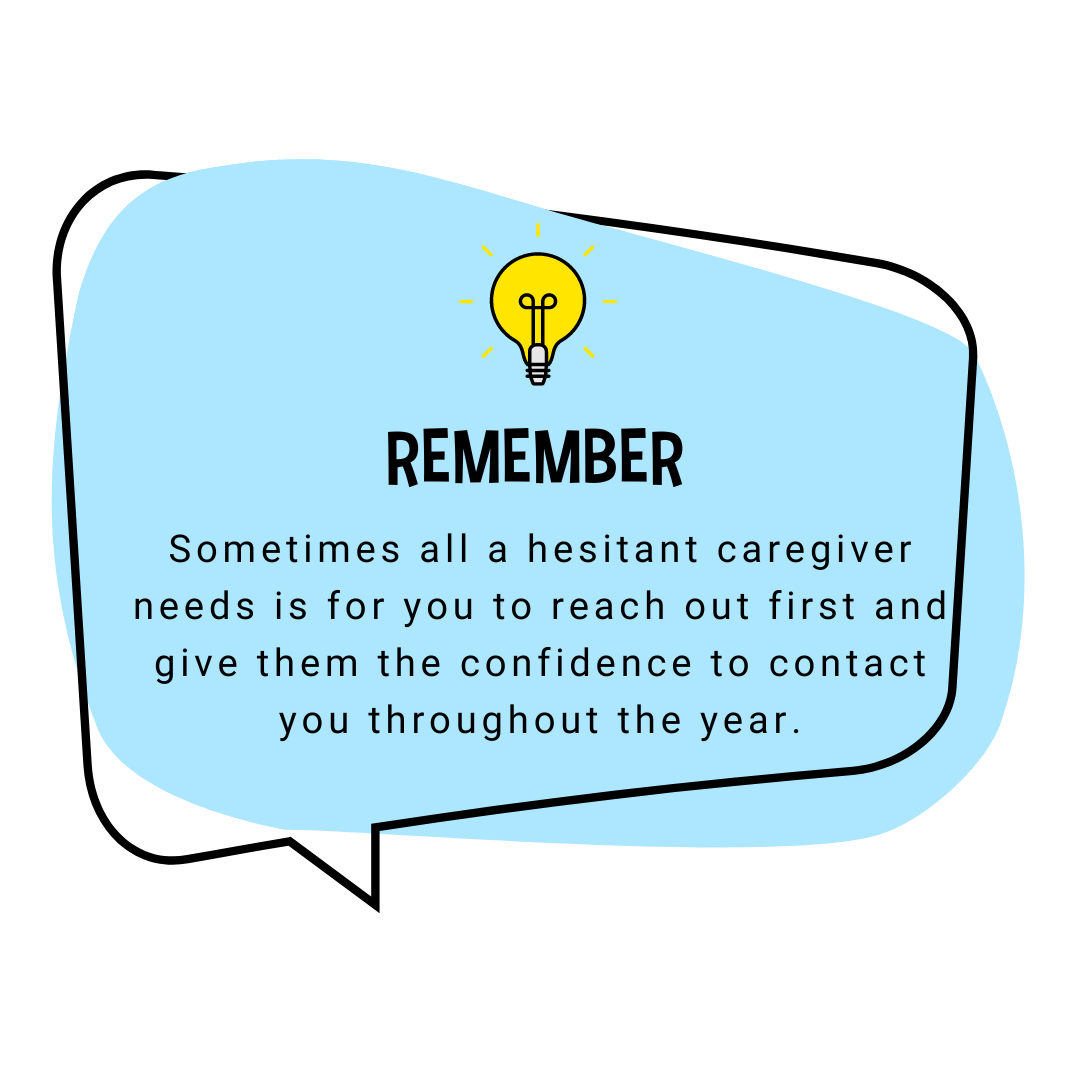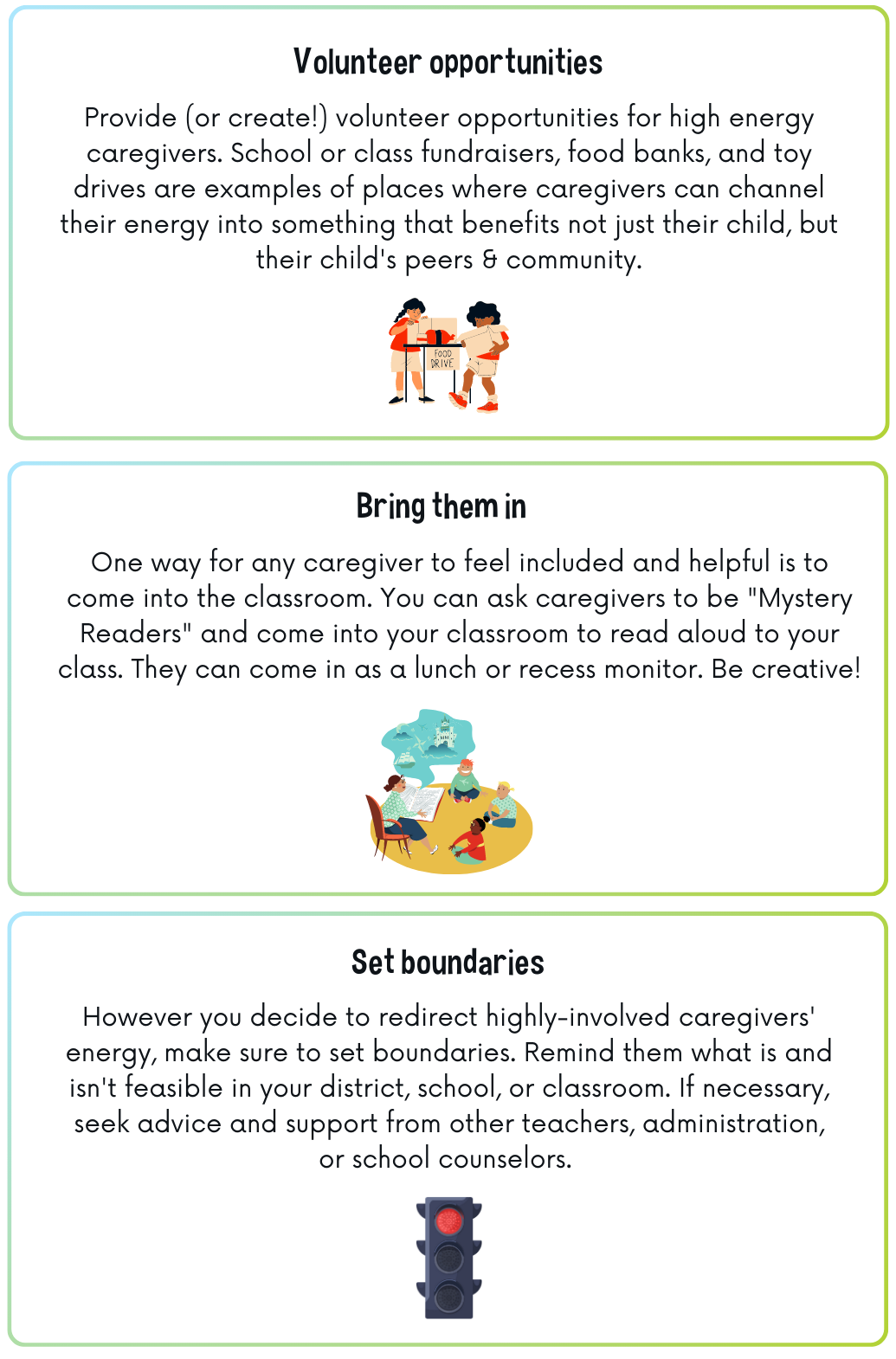By Carissa Lellos
So far in this series, we’ve discussed how important it is to communicate with caregivers. Having a healthy relationship with caregivers can help create a supportive learning environment and foster a positive connection between home and school. This week we’ll take a look at the full spectrum of caregiver involvement, from under- to over-involved, and talk strategies for finding a happy middle ground to ensure student success.
Engaging hesitant caregivers
Some caregivers may be hesitant or reluctant to be involved in their child’s education for a variety of reasons. Their reasons can be anything from working 3 jobs and not having time, to having historically been excluded from the table and not feeling welcome, to simply not knowing enough about how they can get involved. As a general rule, it is always good practice to reserve judgment. Assume that caregivers want what’s best for their children and avoid sweeping generalizations. That is true for the full spectrum of caregiver involvement. With that said, here are four strategies for engaging hesitant caregivers.
Reach out proactively
Meet them where they are
When you teach a child, you meet them where they are to help them reach their future potential. You would never expect a first grader to multiply before they have learned to add. Make sure you apply this important concept to the adults in your students’ lives as well. If you can determine the root of a caregiver’s disengagement, you can meet them where they are. For example: A caregiver never attends conferences or open houses because they can’t get the time off from work. Expressing frustration at their perceived lack of effort will do nothing to draw them in. Instead, try to schedule a time to meet that works for them, even if it means making an exception. When you do meet, listen to their concerns and questions. Celebrate their engagement. Encourage further engagement by acknowledging their efforts.
Be accessible
Make yourself available for questions or concerns. Use a variety of communication methods to ensure that caregivers can contact you in a way that works for both of you. Hesitant caregivers may be struggling to engage due to communication barriers, or may just miss the message. If you use a variety of methods, you have a better chance of reaching them. Learn more about digital and old school communication methods in our previous blog posts.
Provide resources
Offer resources and information that caregivers may find helpful. This can include reading lists, online resources, or community events. If a caregiver is reluctant to be involved due to cultural or linguistic barriers, be sure to offer these resources in an accessible way, whether that’s through translated materials or an interpreter. If your district uses Footsteps2Brilliance, click here for Parent University, our comprehensive collection of caregiver resources available in both English and Spanish.
Managing highly
Involved Caregivers
While hesitant caregivers can be a challenge to engage, overly involved caregivers can also present unique challenges. Mismanaged expectations can lead to stress and burnout for you, the teacher, and disappointment or anger for the caregiver. Just like with under-engaged caregivers, you should always assume that even the most intense behaviors can be explained by a caregiver wanting what’s best for their children. Starting from this place of understanding will help you manage your own emotional responses and use strategies to help caregivers find a happy medium for their engagement. Here are some strategies for managing overly involved caregivers:
Redirect their energy
Encourage caregivers to redirect their energy into positive activities that support their child’s education, such as reading together, volunteering at community events, or organizing other caregivers in support of the classroom. In my previous experience, each class had assigned “Room Parents.” These caregivers mobilized other caregivers in the classroom to help provide back up supplies like tissues and markers and helped me put together community events. They were an invaluable resource! Teaming overly involved caregivers up in support of the classroom community at large is a great way to redirect their energy without discouraging or dismissing them. Here are some other strategies for redirecting highly-involved caregivers’ energies. If you have any tried and true methods, leave us a comment for others to learn from!
Set boundaries and be honest
As we’ve discussed in previous posts, it’s important to set clear boundaries with caregivers to help manage their involvement. Make it clear when and how they can contact you, and establish expectations for their involvement early on and often. It’s also important to be honest with caregivers about what is feasible in the classroom. If you cannot accommodate their requests, explain why in a respectful and supportive manner. Sometimes overly involved caregivers just don’t recognize that what they are asking for is beyond the scope of your job, and will back off if you’re honest with them. That said, if a caregiver still expects more of you than you are able or willing to give, you may need support from administrators to reaffirm your boundaries.
Celebrate their Goldilocks moments
Celebrate student successes and achievements, but also celebrate caregiver involvement that falls in the Goldilocks zone. Acknowledge their commitment and effort, and recognize that their involvement comes from a place of love and concern. Be specific so that the caregiver has an idea of what works well for you and why.
Seek support where needed
Sometimes, despite your best efforts, caregivers may not understand your boundaries. If caregiver involvement is causing disruption or difficulty in your classroom, seek support from other teachers, administrators ,or a school counselor. They may be able to offer guidance and advice on how to manage the situation. Remember that you aren’t alone!
Too much, too little
Just right!
Finding the right balance of caregiver involvement is important for the success of our students. By engaging hesitant caregivers and managing overly involved caregivers, you can find that sweet spot of balanced involvement that creates a supportive learning environment and fosters a positive relationship between home and school.

Join us each week as we cover tips and resources for nurturing caregiver-teacher relationships and increasing community engagement.
Looking for more Teacher Tip Tuesday content? Visit https://www.footsteps2brilliance.com/category/teacher-tip-tuesday/
Not signed up? To learn how to provide your class with access to the Footsteps2Brilliance bilingual literacy program, click here, or sign up to speak to a Footsteps2Brilliance expert here.









